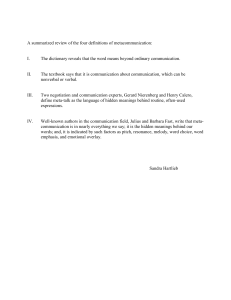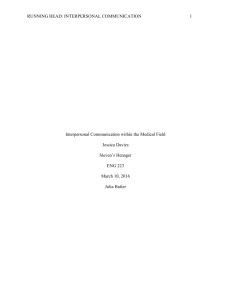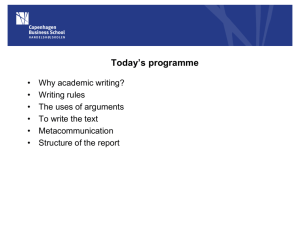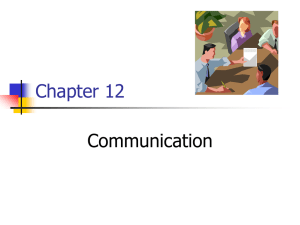Relationship Between Metacommunication among Romantic Partners
advertisement
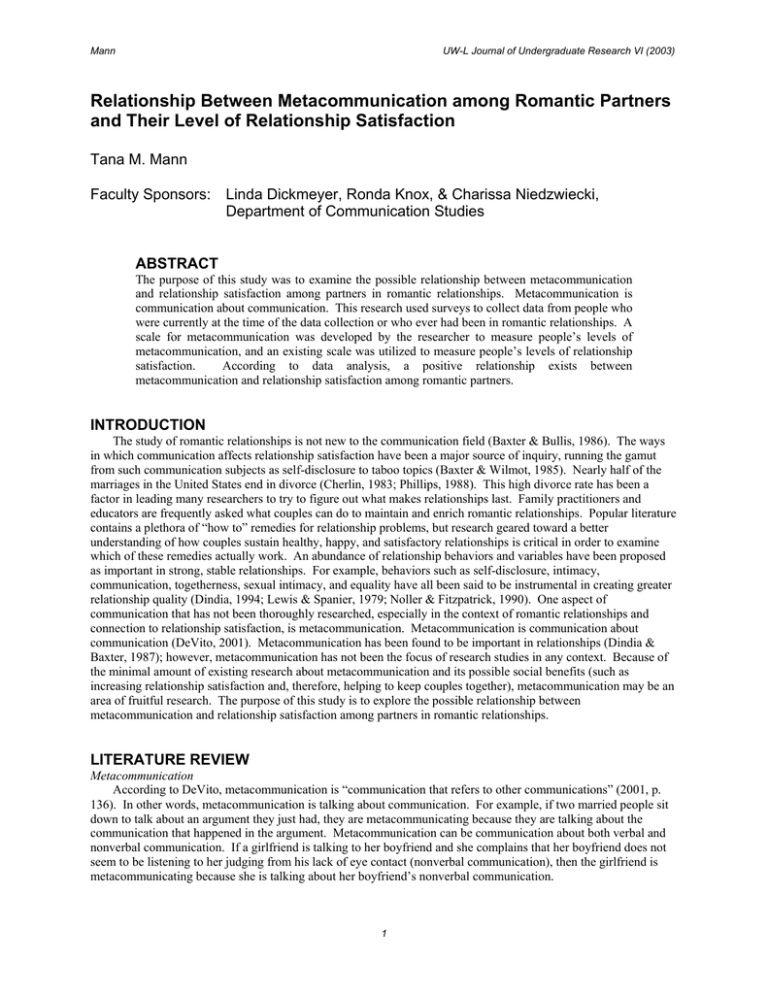
Mann UW-L Journal of Undergraduate Research VI (2003) Relationship Between Metacommunication among Romantic Partners and Their Level of Relationship Satisfaction Tana M. Mann Faculty Sponsors: Linda Dickmeyer, Ronda Knox, & Charissa Niedzwiecki, Department of Communication Studies ABSTRACT The purpose of this study was to examine the possible relationship between metacommunication and relationship satisfaction among partners in romantic relationships. Metacommunication is communication about communication. This research used surveys to collect data from people who were currently at the time of the data collection or who ever had been in romantic relationships. A scale for metacommunication was developed by the researcher to measure people’s levels of metacommunication, and an existing scale was utilized to measure people’s levels of relationship satisfaction. According to data analysis, a positive relationship exists between metacommunication and relationship satisfaction among romantic partners. INTRODUCTION The study of romantic relationships is not new to the communication field (Baxter & Bullis, 1986). The ways in which communication affects relationship satisfaction have been a major source of inquiry, running the gamut from such communication subjects as self-disclosure to taboo topics (Baxter & Wilmot, 1985). Nearly half of the marriages in the United States end in divorce (Cherlin, 1983; Phillips, 1988). This high divorce rate has been a factor in leading many researchers to try to figure out what makes relationships last. Family practitioners and educators are frequently asked what couples can do to maintain and enrich romantic relationships. Popular literature contains a plethora of “how to” remedies for relationship problems, but research geared toward a better understanding of how couples sustain healthy, happy, and satisfactory relationships is critical in order to examine which of these remedies actually work. An abundance of relationship behaviors and variables have been proposed as important in strong, stable relationships. For example, behaviors such as self-disclosure, intimacy, communication, togetherness, sexual intimacy, and equality have all been said to be instrumental in creating greater relationship quality (Dindia, 1994; Lewis & Spanier, 1979; Noller & Fitzpatrick, 1990). One aspect of communication that has not been thoroughly researched, especially in the context of romantic relationships and connection to relationship satisfaction, is metacommunication. Metacommunication is communication about communication (DeVito, 2001). Metacommunication has been found to be important in relationships (Dindia & Baxter, 1987); however, metacommunication has not been the focus of research studies in any context. Because of the minimal amount of existing research about metacommunication and its possible social benefits (such as increasing relationship satisfaction and, therefore, helping to keep couples together), metacommunication may be an area of fruitful research. The purpose of this study is to explore the possible relationship between metacommunication and relationship satisfaction among partners in romantic relationships. LITERATURE REVIEW Metacommunication According to DeVito, metacommunication is “communication that refers to other communications” (2001, p. 136). In other words, metacommunication is talking about communication. For example, if two married people sit down to talk about an argument they just had, they are metacommunicating because they are talking about the communication that happened in the argument. Metacommunication can be communication about both verbal and nonverbal communication. If a girlfriend is talking to her boyfriend and she complains that her boyfriend does not seem to be listening to her judging from his lack of eye contact (nonverbal communication), then the girlfriend is metacommunicating because she is talking about her boyfriend’s nonverbal communication. 1 Mann UW-L Journal of Undergraduate Research VI (2003) Research on metacommunication is not abundant; however, some studies do exist. Patch and Hoang (1997) studied the use of metacommunication in compliance-gaining strategies. Patch and Hoang (1997) found that a person who is asked to comment explicitly on the appropriateness of a single request may find it less distressing to comply with the request than to engage in a metacommunicative confrontation with the requester. This study was tested among strangers and not in a romantic relationship context, however. Another study done by Patch (1995) found that the use of metacommunication led to higher ratings of power and tension. Patch’s (1995) study discovered that metacommunication is more stressful when a friend is involved than when a stranger or a casual acquaintance is involved because metacommunication seems to generate more feelings of rudeness and tension between friends than between strangers or acquaintances. Another finding was that metacommunication was considered to be less acceptable among friends than among strangers. Patch’s (1995) data came from scenario judgment studies that tested metacommunication in the contexts of friends and strangers. Patch (1995) stated at the end of his research that the significance of metacommunication should be explored in future research across a broader spectrum of relationship contexts. The use of metacommunication in families has been a lightly touched-on area of research. One study discussed the types of reported talk and the differences between mothers’ and fathers’ usage of metacommunication (Ely, Gleason, Narasimhan, & McCabe, 1995). This study found that mothers used reported speech, or reports of one’s own or someone else’s past speech, far more frequently than did fathers or children. Again, this study was not completed within the context of a romantic relationship. Studies have found that many aspects of relationships and communication relate to gender. With respect to awareness, Burnett (1987) reported that women thought about their relationships more than men and were also more comfortable in talking about their relationships than men. Acitelli (1992) found that proportionately, women spend more time than men in talking about their relationships. Gender differences in metacommunication among romantic partners have not been studied, which may further justify research intending to explore metacommunication among romantic partners. In the context of romantic relationships, some research has been completed relating to metacommunication; however, metacommunication and its effects on relationships have not been the focus of these studies (Dindia & Baxter, 1987; Sillars, Weisberg, Burggraf, & Wilson, 1987). In a study done by Dindia and Baxter (1987), metacommunication was found to occur more frequently when the goal was repairing a relationship than when the goal was maintaining a relationship. Baxter and Wilmot (1985) studied taboo topics in close relationships and found that certain conversation topics were avoided in relationships because of the negative relational metacommunication implicit in those topic categories. Newman (1981) wrote an article linking attribution-making with metacommunication in ongoing, intimate relationships. Newman states that metacommunication can be “a message which signals how a person intends a message, how a person wants the message to be answered, how a person is attempting to define the relationship, etc” (1981, p. 124). Newman (1981) also points out that one person’s interpretation of metacommunication may be distinct from another person’s intended metacommunication. Newman suggests, “[K]nowledge of implicit attribution-making, or interpreted metacommunications, might aid in the prediction of subsequent interpersonal responses” (1981, p. 125). Attributions constitute the cognitive counterparts to actual messages of metacommunication. Attribution-making could either accompany a person’s experience of a particular interpersonal event or could follow that experience over various stages of time; it could be invoked with varying degrees of conscious thought, and it could serve to explain either one’s own communicative responses or the responses of a partner. The verbalization of attributions between partners could lead into the process of “intentional metacommunication” as described by Perlmutter and Hatfield (1980). These authors claim that while metacommunication accompanies all messages and is often unconscious, intentional metacommunication occurs when people talk consciously about the relational context of their messages. The possibilities for actual change in the relationship begin at the level of intentional metacommunication. Newman (1981) claims, “To what extent intentional metacommunication actually occurs, and actually facilitates relational change, is a subject in need of further investigation” (1981, p. 129). Baxter and Bullis (1986) found that about half of the turning points in developing romantic relationships involved explicit metacommunication between the relationship parties. Baxter and Bullis’s (1986) research also had another important finding. According to this study, neither partner agreement nor the presence of explicit metacommunication was related to the respondent’s current satisfaction with the relationship. Trenholm and Jensen (2000) claim that metacommunication is valued in healthy relationships, but no research is cited to back up this claim or to explain how metacommunication contributes to a healthy relationship. 2 Mann UW-L Journal of Undergraduate Research VI (2003) Relationship Satisfaction According to Dainton, Stafford, and Canary (1994), relationship satisfaction is generally defined as “an individual’s attitude toward the partner and the relationship, typically in terms of the perceived quality of the relationship” (p. 90). Many of the studies that test relationship satisfaction examine the connection between relationship satisfaction and relational maintenance behaviors (Dainton, 2000; Wiegel & Ballard-Reisch, 1999; Ragsdale, 1996). A number of typologies of specific relationship maintenance behaviors have developed. Arguably, the most widely recognized is the typology developed by Canary and Stafford (1992). When creating the typology, Canary and Stafford (1992) asked people in romantic relationships what they do to maintain a satisfactory relationship. Answers to their question were grouped into five common types of behaviors: positivity, openness, assurances, network, and sharing tasks. Beyond merely identifying maintenance behaviors, Canary and Stafford (1994) contend that the use of these maintenance behaviors is associated with higher perceptions of satisfaction, commitment, and liking. Marital satisfaction provides a global assessment of the current state of a relationship and, as Sabatelli (1988) points out, it is one of the most widely studied indicators of happy, stable relationships. Marital satisfaction is often viewed as “an individual’s attitude toward the partner and the relationship” (Dainton, Stafford, & Canary, 1994, p. 90). Dainton’s study (2000) found that the more an individual perceives his or her partner as using maintenance behaviors relative to his/her own expectation, the more satisfied the individual was with the relationship. This study also discovered a positive, linear relationship between the extent to which an individual’s expectations for his or her partner’s use of maintenance behaviors were met and his or her own relational satisfaction. Another finding of Dainton’s (2000) research was the evidence that actual behaviors are relatively more important in predicting satisfaction than are discrepancies between actual and expected behaviors. Dindia and Baxter (1987) found no relationship between maintenance/repair strategies and marital satisfaction. Dindia and Baxter assert, “[T]he absence of a significant relationship between strategy choice and satisfaction suggests that belief in communication and togetherness may be a cultural folk myth, not actuality” (1987, p. 155). A statement such as this deserves and requires further inquiry. Newman’s (1981) article states that both verbalized and unverbalized interpersonal attributions might reflect those interpersonal and intrapersonal perceptions which sustain particular patterns of relating and contribute to relationship satisfaction or dissatisfaction. So, relationship satisfaction has been researched when linked to a number of concepts studied in the communication field; however, relationship satisfaction’s link to metacommunication has not been studied and, therefore, may be a copious relationship to research. Research on metacommunication is limited, especially in the context of romantic relationships and how metacommunication relates to relationship satisfaction. Research on metacommunication and relationship satisfaction exists, but the two concepts are rarely related to one another. When considering reality, logic leads one to think that communication about communication would lead to greater levels of relationship satisfaction. Textbooks make claims about how metacommunication betters relationships in various ways; however, research is not cited to uphold such claims. The high divorce rate in our country shows that a real world need exists for research on what leads to higher levels of relationship satisfaction and, therefore, keeps people together. Research on the relationship between metacommunication and relationship satisfaction in romantic relationships could help solve many research and societal problems. Therefore, since studies in the past have not examined the possible link between metacommunication and relationship satisfaction within romantic relationships, a relationship between the two concepts must be addressed and tested. In light of this limitation of past research and the need to establish the existence of a relationship between metacommunication and relationship satisfaction before inquiring further about the nature of their relationship, the following research question was proposed: RQ1: Is there a relationship between metacommunication among romantic partners and their level of relationship satisfaction? METHOD Participants This research utilized a couple of nonrandom sampling methods: convenience and network sampling. Students and staff in numerous classes and organizations at a midwestern university were sampled. Only students and staff who had been in or were currently in romantic relationships were allowed to participate. The sampling of university students and staff was a convenience sample, and anyone who fit the romantic relationship requirement was asked to 3 Mann UW-L Journal of Undergraduate Research VI (2003) fill out a questionnaire. Network sampling was also utilized in order to gain more respondents, especially respondents who were not university students. Using this data collection technique, 242 surveys were completed and returned. The age of participants ranged from 18 to 56 (M=22.45 years, SD=5.50). One hundred eighty-five subjects were female, and fifty-seven subjects were male. The length of participants’ romantic relationships ranged from one month to sixteen years with an average relationship length of 2.01 years. One hundred forty-eight participants were currently in romantic relationships at the time of the study, and 94 participants had been in romantic relationships in the past. Regarding relationship status, 10.3% classified their status as casually dating, 45.0% as dating, 6.6% as engaged, 6.2% as married, 26.4% as committed, and 5.4% as committed partnership. When asked about their race and ethnicity, 1.7% of the subjects identified as American Indian or Alaska Native, .8% as Asian, 4.1% as Black or African American, 4.5% as Hispanic or Latino, 87.6% as White, and 1.2% identified as other. In terms of education, .8% of participants were high school graduates or less, 90.5% had some college, 6.6% were college graduates, .8% completed some graduate school, .8% had Master’s degrees, and .4% had a Ph.D. Lower class participants were 7.4% of the sample, middle class were 84.7%, and upper class were 7.9%. Six respondents identified as lesbian, 4 identified as gay, 7 identified as bisexual, 223 identified as heterosexual, and 2 identified as other. Measures Subjects were asked to complete the newly developed Metacommunication Scale and the Houston, McHale and Crouter (1986) Marriage Opinion Scale in reference to their current or a past romantic relationship. The Metacommunication Scale is a 20-item instrument developed to measure the degree to which participants perceive that they metacommunicate and the degree to which participants perceive that their partners metacommunicate. Responses for the Likert-type scale items range from almost always true of me (5) to never true of me (1). Cronbach’s alpha coefficient of reliability was computed at .88 in this study. The Houston, McHale and Crouter (1986) Marriage Opinion Scale was used to measure relationship satisfaction. This scale is an eleven-item instrument and a seven-point semantic differential-type scale on which respondents are asked to indicate on a continuum how closely the opposing adjectives describe their relationships. Minor adjustments, like changing the instructions from thinking about one’s marriage to thinking about one’s romantic relationship, were needed in order to adapt this scale for the proposed research. Cronbach’s alpha coefficient of reliability was computed at .93. Scale Development The Metacommunication Scale was developed during the fall semester of 2002. A 20-item scale was developed for metacommunication based on DeVito’s (2001) list of different forms of metacommunication. The forms given by DeVito were expanded for the scale. For example, in his list of forms of metacommunication, DeVito listed “Confront contradictory or inconsistent messages.” This form was then expanded to “Confront contradictory or inconsistent verbal messages that your partner says,” “Confront contradictory or inconsistent verbal messages that you say,” “Confront contradictory or inconsistent nonverbal and verbal messages that your partner does/says,” and “Confront contradictory or inconsistent nonverbal and verbal messages that you do/say” in order to more fully include all forms of possible metacommunication for the scale. Each item of the Metacommunication Scale has an explanation and an example in order to help participants understand what the item means. The scale is divided into two parts. The first part of the scale has ten items designed to measure the degree to which the research participant believes that he or she metacommunicates. The second part of the scale has ten items designed to measure the degree to which the participant believes that her or his partner metacommunicates. Participants are asked to indicate on a Likert scale how much each scale item applies to either her/him or her/his partner. The Metacommunication Scale appears to be valid. The measure has face validity in that it looks like it measures metacommunication. The scale also has expert jury validity. A number of communication experts were consulted about the validity of the Metacommunication Scale, and only positive assessments were given about the measure’s validity. In order to test the reliability of the Metacommunication Scale, a pilot study was conducted. In the spring of 2003, a class of 22 students tested the questionnaire for this study. Respondents were asked if they had any problems with the questionnaire in terms of format, instructions, and understandability. No problems were indicated. Cronbach’s alpha coefficient of reliability was computed at .86 for the Metacommunication Scale in the pilot study. The scale was factor analyzed, but deleting items did not significantly raise the reliability of the scale, so all of the original items were kept in the scale for this study. A minor adjustment in the demographics section of the questionnaire was the only change made between the pilot study questionnaire and the actual study 4 Mann UW-L Journal of Undergraduate Research VI (2003) questionnaire. The reliability of the Houston, McHale and Crouter (1986) Marriage Opinion Scale was also computed in the pilot study. Cronbach’s alpha coefficient of reliability for that scale was .94. Procedure The type of research conducted for this study was descriptive empirical research. According to Reinard (2001), empirical research is “all communication research that tests statements against data” (p. 224). Descriptive empirical research “involves gathering fresh data to survey a matter” (p. 224). Since the intent of this study was to gather fresh data to survey metacommunication and its possible link to relationship satisfaction, descriptive empirical research was a suitable type of research to accomplish the goals of this study. This study used surveys to collect data. According to Reinard (2001), a survey is “a study that uses questionnaires or interviews to discover descriptive characteristics of phenomena” (p. 225). Specifically, this study used questionnaires to collect data. Questionnaires are “survey forms in which individuals respond to items they have read” (Reinard, 2001, p. 441). Questionnaire surveys were appropriate means to collect data for this research since the study was looking for a relationship between the two variables and comparison of the answers given to the measures provided for metacommunication and relationship satisfaction on the questionnaires established whether a relationship existed or not. This study was mostly a quantitative study, which means that observations of the data were expressed predominantly in numerical terms (Reinard, 2001). A few open-ended qualitative questions were also included in the metacommunication measure on the questionnaire, however. The questionnaire for this study was developed during the fall semester of 2002. The questionnaire consisted of demographic information, the metacommunication measure, and the relationship satisfaction measure. The demographic information included sex, age, ethnic background, education information, income information, sexuality, classification of the romantic relationship (dating, engaged, married, etc.), and length of the relationship. In the spring semester of 2003, the questionnaire was distributed in university classrooms and organizations where professors or organization leaders had given permission to conduct the research. The researcher verbally read over the instructions for the questionnaire and explained the romantic relationship requirement to research participants. According to Baxter and Wilmot, a romantic relationship is “a relationship that [a] respondent perceive[s] as explicitly romantic by mutual agreement of both parties” (1985, p. 256). For the sake of this study, people who were casually dating, dating, engaged, married, committed, or in committed partnerships in homosexual or heterosexual relationships during the time of the study’s data collection were considered to be in romantic relationships. For people who were not in a romantic relationship during the time of data collection, if they ever had been in such a relationship in the past, they were also asked to complete a questionnaire based on that relationship. People who had never been in a romantic relationship were not able to take part in the study. People who fit the requirement were given questionnaires. The researcher remained in the room during the administration of the questionnaires in order to be available to answer any questions. Respondents returned the questionnaires to the researcher upon completion. Data obtained from the questionnaires were entered into a computer and analyzed with results computed by the computer program SPSS. RESULTS Since the research question for this study was concerned with finding a relationship between metacommunication and relationship satisfaction, the main statistical test was a measure of association or correlation between the Metacommunication Scale and the relationship satisfaction scale. So, regarding the research question, “Is there a relationship between metacommunication among romantic partners and their level of relationship satisfaction?,” results of the data analysis for this study indicated that the Metacommunication Scale score was slightly, significantly, and positively correlated with the relationship satisfaction scale score (r = .189, p < .01). The range for the Metacommunication Scale scores was from 33 to 96 (M=64.72, SD=11.05). The relationship satisfaction scale scores ranged from 14 to 77 (M=61.35, SD=11.28). A score was also computed for the section of the Metacommunication Scale that deals with the degree to which the participant perceives that he/she metacommunicates, which will be called the U-Metacommunication score, and for the section of the Metacommunication Scale that measures the degree to which the participant perceives that his/her partner metacommunicates, which will be called the P-Metacommunication score. The range for the UMetacommunication score was from 15 to 49 with a mean of 34.19 and a standard deviation of 6.14. The range for the P-Metacommunication score was from 12 to 50 with a mean of 30.53 and a standard deviation of 6.87. The data for this study showed that the U-Metacommunication score was moderately, significantly, and positively correlated with the P-Metacommunication score (r =.442, p < .01). 5 Mann UW-L Journal of Undergraduate Research VI (2003) Further analysis of the U-Metacommunication and P-Metacommunication scores with the relationship satisfaction scale score led to the finding that the P-Metacommunication score was significantly and positively correlated with relationship satisfaction (r =.265, p < .01), but the U-Metacommunication score was not significantly related to relationship satisfaction (r =.044). The demographic information given by the subjects of this study provided more avenues for findings. Regarding length of relationship, the data from this study revealed that the correlation between length of the relationship and the relationship satisfaction scale score was not significant (r =.104). The correlations between relationship length and all of the metacommunication scores (the Metacommunication Scale score, UMetacommunication score, and P-Metacommunication score) were not significant either, but the correlations were all negative (r = -.067, -.074, -.042 respectively). Age of the respondents was also negatively related to all of the metacommunication scores (the Metacommunication Scale score, U-Metacommunication score, and P-Metacommunication score), but these correlations were slightly significant (r = -.221, -.237, -.145 respectively, p < .01). T-tests were utilized to examine any differences between men and women in terms of metacommunication. Females reported higher UMetacommunication scores than males (M=34.88, M=31.95 respectively), but the difference in the means was not statistically significant. A t-test also revealed that people who were currently in romantic relationships at the time of the study reported higher relationship satisfaction scores than people who had been in a relationship in the past (M=66.41, M=53.39 respectively), and the difference between these means was statistically significant (t =10.57, p < .001). Due to the lack of variation in participants in terms of race and ethnicity, educational background, economic level, sexual orientation, and relationship classification, further analyses based on these factors were not pursued. DISCUSSION According to the results of this study, there is a relationship between metacommunication among romantic partners and their level of relationship satisfaction. The results suggest that this relationship is positive or direct, meaning that as metacommunication goes up, relationship satisfaction also goes up. A positive relationship between these two variables seems to be likely when considering reality, especially in light of the fact that most people think communication is an important part of their romantic relationships. Numerous respondents in this study commented in the open-ended questions on the questionnaire that they see metacommunication as an important part of their romantic relationships with their partners. Metacommunication can be another tool that couples use to self-disclose and be more open and honest with each other, so the finding that metacommunication was related to relationship satisfaction seems reasonable. Another finding of the study was that the degree to which subjects perceived that they metacommunicated and the degree to which they perceived that their partners metacommunicated were positively correlated with moderate significance. So, if one partner in a relationship metacommunicates, then the other is also likely to metacommunicate. This result makes sense in lieu of the reciprocal nature of self-disclosure. The degree to which respondents perceived that they metacommunicated differed from the degree to which they perceived that their partners metacommunicated when relating the two measures of metacommunication to relationship satisfaction, however. The degree of partner metacommunication was positively and significantly related to relationship satisfaction in this study. The degree of the participants’ metacommunication was also positively correlated to relationship satisfaction, but this correlation was not significant, suggesting that the partners’ levels of metacommunication were seen by the respondents as more important for relationship satisfaction than their own levels of metacommunication. The correlation between the length of the relationship and the level of relationship satisfaction was found to be positive but not significant in this study. This result is surprising if one assumes that relationships get better and more satisfying over time. However, the fact that relationship length was not significantly related to relationship satisfaction makes sense if one considers that the beginning of a relationship is when people are usually excited to be around each other, are just starting to get to know one another, and, therefore, are not discussing difficulties in their relationship. The beginnings of romantic relationships are often marked by high levels of relationship satisfaction. However, as the relationship grows, more and more difficulties often enter into the relationship, and the euphoria of a new relationship starts to wear off. This growing dose of reality that gradually becomes part of many relationships may help to explain why the correlation between length of the relationships and satisfaction was not more significant. Length of the relationships and ages of respondents were both negatively correlated with metacommunication. As the length of the relationships got longer and the age of the respondent got older, the less the respondents 6 Mann UW-L Journal of Undergraduate Research VI (2003) indicated a high degree of metacommunication in their relationships. This result is reasonable if one considers that as relationships go on and people get older together, they do not have to talk to one another about some issues because they know each other so well. In this study, women perceived that they metacommunicated more than men perceived that they metacommunicated, but this difference was not statistically significant. The lack of significance in this result seems to contradict the popular notion in our culture that women talk more than men, especially in the context of romantic relationships. The lack of significance may mean that there is less of a difference in the ways that men and women communicate than popular culture and research suggest, or the lack of significance may be due to the considerably smaller number of men that were surveyed for this study. People who were in romantic relationships at the time of the study reported more relationship satisfaction than people who reported on past romantic relationships. This finding is not surprising because people who are satisfied with relationships tend to stay in those relationships, and people who are not satisfied with relationships tend to get out of those relationships. This research produced a number of significant and interesting results, but the study had some limitations. First of all, the sampling method may have limited the study. Since nonrandom sampling methods were utilized, the sample may be biased. Most of the respondents to the questionnaires were female, white, middle class, heterosexual students at a midwestern university, despite attempts to gain a more representative sample. This homogenous sample may not have provided data that would be representative of the whole population of people in romantic relationships. Therefore, analysis of the data from the nonrandom sample for this study may not be generalizable to the population. Random sampling of a more diverse population would be a fruitful endeavor for future research. However, despite these possible limitations, this study was worthwhile. This research embarked on uncharted territory in the field of communication and provided significant findings that may be useful not only in the communication field but in society as well. CONCLUSION The revelation that metacommunication is positively correlated to relationship satisfaction opens up a whole new path that scholars may use to conduct new research and couples may use to have better relationships. Now communication textbooks that claim that metacommunication is important for romantic relationships have proof for their assertions. The Metacommunication Scale can be used in future research projects that study a more diverse sample than this study did, that look at contexts other than romantic relationships, and that want to study aspects of communication other than relationship satisfaction. This study also has practical uses. This research in no way found evidence that higher levels of metacommunication between people always lead to relationship satisfaction. This study simply found another route that may take people to a more satisfying relational experience. Metacommunication may be a tool that some couples could use to better their relationships. This tool probably will not work for every couple, but a solution for one couple is rarely the solution for all. Learning how to metacommunicate and how to value metacommunication may not be the answer to every relationship problem that romantic partners may face, but that knowledge may help some people. In a country whose people have so many difficulties working out problems with their partners and staying together, one more tool that people could utilize to strengthen their relationships can only help. ACKNOWLEDGEMENTS First of all, I wish to thank the Communication Studies faculty for all of their help and support. Specifically I would like to thank Linda Dickmeyer, Ronda Knox, Charissa Niedzwiecki, Mike Tollefson, Doug Swanson, and Rick Rodrick for helping me develop my metacommunication measure, allowing me to give out surveys in their classes, giving me advice, and everything else they did for me. I would also like to thank the Undergraduate Research Grant committee for funding this research. Lastly, I would like to thank my mom, dad, sister, and boyfriend for their unconditional love and encouragement. 7 Mann UW-L Journal of Undergraduate Research VI (2003) REFERENCES Acitelli, L. (1992). Gender differences in relationship awareness and marital satisfaction among young married couples. Personality and Social Psychology Bulletin, 18, 102-110. Baxter, L., & Bullis, C. (1986). Turning points in developing romantic relationships. Human Communication Research, 12, 469-493. Baxter, L., & Wilmot, W. (1985). Taboo topics in close relationships. Journal of Social and Personal Relationships, 2, 253-269. Burnett, R. (1987). Reflections in personal relationships. In R. Burnett, P. McGhee, & D. Clarke (Eds.), Accounting for relationships: Explanation, representation and knowledge (pp. 74-93). London: Methuen. Canary, D., & Stafford, L. (1992). Relational maintenance strategies and equity in marriage. Communication Monographs, 59, 243-267. Canary, D., & Stafford, L. (1994). Maintaining relationships through strategic and routine interaction. In D. Canary & L. Stafford (Eds.), Communication and relational maintenance (pp. 3-21). San Diego: Academic. Cherlin, A. (1983). The trends: Marriage, divorce, remarriage. In A. S. Skolnick & J. H. Skolnick (Eds.), Family in transition (4th ed., pp. 128-137). Boston: Little & Brown. Dainton, M. (2000). Maintenance behaviors, expectations for maintenance, and satisfaction: Linking comparison levels to relational maintenance strategies. Journal of Social and Personal Relationships, 17, 827-842. Dainton, M., Stafford, L., & Canary, D. (1994). Maintenance strategies and physical affection as predictors of love, liking, and satisfaction in marriage. Communication Reports, 7, 89-98. DeVito, J. (2001). The interpersonal communication book (9th ed.). New York: Addison Wesley Longman, Inc. Dindia, K. (1994). A multiphasic view of relationship maintenance strategies. In D. Canary & L. Stafford (Eds.), Communication and relational maintenance (pp. 91-112). San Diego: Academic. Dindia, K., & Baxter, L. (1987). Strategies for maintaining and repairing marital relationships. Journal of Social and Personal Relationships, 4, 143-158. Ely, R., Gleason, J., Narasimhan, B., & McCabe, A. (1995). Family talk about talk: Mothers lead the way. Discourse Processes, 19, 201-218. Houston, T., McHale, S., & Crouter, A. (1986). When the honeymoon’s over: Changes in the marriage relationship over the first year. In R. Gilmour & S. Duck (Eds.), The emerging field of personal relationships (pp. 109132). Hillsdale, NJ: Lawrence Erlbaum. Lewis, R., & Spanier, G. (1979). Theorizing about the quality and stability of marriage. In W. Burr, R. Hill, F. Nye, & I. Reiss (Eds.), Contemporary theories about the family (pp. 268-294). New York: Free Press. Newman, H. (1981). Interpretation and explanation: Influences on communicative exchanges within intimate relationships. Communication Quarterly, 29, 123-131. Noller, P., & Fitzpatrick, M. (1990). Marital communication in the eighties. Journal of Marriage and Family, 52, 832-843. Patch, M. (1995). The effect of asymmetrical use of metacommunicative behavior on judgments of power. Journal of Social Psychology, 135, 747-754. Patch, M., & Hoang, V. (1997). The use of metacommunication in compliance: Door-in-the-face and single-request strategies. Journal of Social Psychology, 137, 88-95. Perlmutter, M., & Hatfield, E. (1980). Intimacy, intentional metacommunication, and second order change. American Journal of Family Therapy, 8, 17-23. Phillips, R. (1988). Putting asunder: A history of divorce in Western society. Cambridge: Cambridge University Press. Ragsdale, J. (1996). Gender, satisfaction level, and the use of relational maintenance strategies in marriage. Communication Monographs, 63, 354-369. Reinard, J. (2001). Introduction to communication research (3rd ed.). New York: McGraw-Hill. Sabatelli, R. (1988). Measurement issues in marital research: A review and critique of contemporary survey instruments. Journal of Marriage and the Family, 50, 891-915. Sillars, A., Weisberg, J., Burggraf, C., & Wilson, E. (1987). Content themes in marital conversations. Human Communication Research, 13, 495-528. Trenholm, S., & Jensen, A. (2000). Interpersonal communication (4th ed.). Belmont: Wadsworth Publishing Company. Wiegel, D., & Ballard-Reisch, D. (1999). How couples maintain marriages: A closer look at self and spouse influences upon the use of maintenance behaviors in marriages. Family Relations, 48, 263-270. 8
